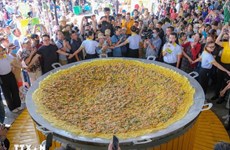Hanoi’s old Buddhist pagodas get special national relic status
Two ancient Buddhist pagodas in the west of Hanoi – Tay Phuong and Thay –
received certificates recognising them as special national relic sites
on April 23.
Two ancient Buddhist pagodas in the west of Hanoi – Tay Phuong and Thay –
received certificates recognising them as special national relic sites
on April 23.
The event coincided with the opening of the two pagodas’ festival, which gather crowds of local residents and tourists who come to worship and to enjoy a range of traditional activities and art performances.
The Tay Phuong Pagoda, located in the outlying district of Thach That, is renowned for its architecture and elaborate carvings typical of the 18th century, notably a collection of more than 70 Buddha wood statues in diverse sizes which have been recognised as national treasures.
Among the sculptures, each of which features a distinct posture and facial expression.
Legend has it that the Tay Phuong Pagoda was built along time ago and reconstructed in the 16th and 18th centuries.
The pagoda includes three separate two-storey buildings, with brick architecture featuring long roof arches. Each roof has eight apexes, carved of the four supernatural creatures: dragon, unicorn, tortoise and phoenix, among other subtle patterns.
The Thay Temple, located in Quoc Oai district, was built in the Ly Dynasty 11 th century on the foot of the Sai Son mountain.
It houses a national treasure, the trinity statues of the Amitabha Buddha, flanked by two Bodhisattvas representing wisdom and compassion in Pureland Buddhism. The statues are considered the sculptural pinnacle of the flourishing period of Buddhism in Vietnam.
The ancient temple also houses many other valuable artefacts, such as the lotus-shaped stone pedestals which researchers say date back to the Ly or Tran dynasties, 11 th -15 th centuries.
Besides traditional religious rituals, the Thay Temple festival features water puppet shows in a lake in front of the main hall to honour the founder of this art, Zen master Tu Dao Hanh (1072-1116).-VNA
The event coincided with the opening of the two pagodas’ festival, which gather crowds of local residents and tourists who come to worship and to enjoy a range of traditional activities and art performances.
The Tay Phuong Pagoda, located in the outlying district of Thach That, is renowned for its architecture and elaborate carvings typical of the 18th century, notably a collection of more than 70 Buddha wood statues in diverse sizes which have been recognised as national treasures.
Among the sculptures, each of which features a distinct posture and facial expression.
Legend has it that the Tay Phuong Pagoda was built along time ago and reconstructed in the 16th and 18th centuries.
The pagoda includes three separate two-storey buildings, with brick architecture featuring long roof arches. Each roof has eight apexes, carved of the four supernatural creatures: dragon, unicorn, tortoise and phoenix, among other subtle patterns.
The Thay Temple, located in Quoc Oai district, was built in the Ly Dynasty 11 th century on the foot of the Sai Son mountain.
It houses a national treasure, the trinity statues of the Amitabha Buddha, flanked by two Bodhisattvas representing wisdom and compassion in Pureland Buddhism. The statues are considered the sculptural pinnacle of the flourishing period of Buddhism in Vietnam.
The ancient temple also houses many other valuable artefacts, such as the lotus-shaped stone pedestals which researchers say date back to the Ly or Tran dynasties, 11 th -15 th centuries.
Besides traditional religious rituals, the Thay Temple festival features water puppet shows in a lake in front of the main hall to honour the founder of this art, Zen master Tu Dao Hanh (1072-1116).-VNA












